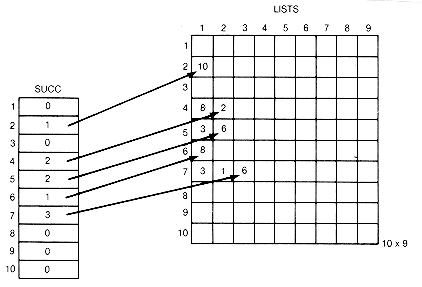2. Suppose, instead of using the sample implementation, you do the following to keep successor information: Declare lists to be an n(n - 1) two-dimensional array and keep the successors of object i in the ith row of lists. For the example, after phase I, lists would be This two-dimensional lists array takes up the same total amount of storage as the one-dimensional lists array of the better implementation. For both implementations, the limiting factor on whether or not the program will run might then be the value of n beyond which available storage is exhausted. Suppose you are willing to give up the guarantee that topsort will always run correctly. This means you may attempt to run problems whose n is large enough that you are not sure whether the implementation of lists can hold all successors. Discuss the relative advantages of the implementations.
3. This is the same as Assignment 1 except, instead of the lists array, use dynamic memory to store the successor lists.
4. Assume your program for Assignment 1 treated the bag with the operations empty-bag, remove, and baginitialization and count with the operations predinitialization and increase as data abstractions.
a. What does this mean?
b. Write a function, number, that also treats them as data abstractions and returns the number of objects in the bag when it is invoked. When it returns, the bag must contain exactly the same objects as before number was invoked. Assume number does not have access to information about the output ranking.
